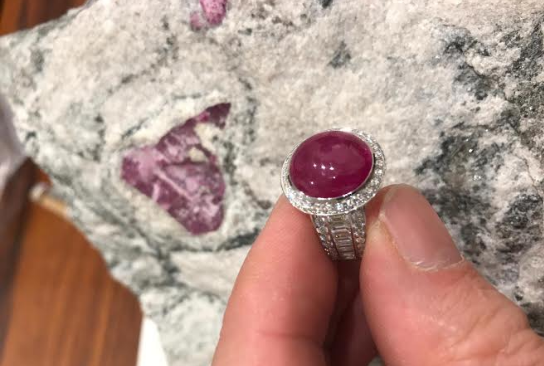Diamond News Archives
- Category: News Archives
- Hits: 1146

(IDEX Online) – Greenland Ruby, Greenland’s only miner of ruby and pink sapphire, has announced that Hartmann’s Jewellery, a Danish luxury brand, is introducing a collection of jewels using Greenlandic rubies and pink sapphires. <?xml:namespace prefix = "o" ns = "urn:schemas-microsoft-com:office:office" /?>
The Hartmann collection features more than 50 pieces of Greenlandic ruby and pink sapphire jewelry using a total of approximately 300 carats of rubies and pink sapphires. It was designed by Hartmann's design team, and the prices range from $1,500 - $45,000. The collection is currently available in Scandinavia, Greenland Ruby said in a statement.
“Though other designers have worked with our gems, Hartmann’s is the first jewelry brand to create an entire collection,” said Greenland Ruby VP Sales and Marketing Hayley Henning. “We’re especially delighted to welcome a Danish retailer as our first full partner, given Denmark’s long relationship with Greenland.”
Ulrik Hartmann, founder and owner of Hartmann’s, visited Greenland Ruby’s Aappaluttoq mine near the southeast coast of Greenland in August, with Danish television cameraman Michel van Steenwijk, to record his visit. Hartmann’s campaign to introduce Greenland Ruby’s rubies and pink sapphires this fall includes video and still photography of the pristine arctic scenery he experienced on his visit, which he is sharing on his website and social media.
Hartmann traveled to Aappaluttoq by water from Greenland’s capital, Nuuk. The four-hour boat journey is only possible in summer, due to Greenland’s arctic climate.
“The idea that corundum formed beneath this incredible landscape three billion years ago intrigued me,” says Hartmann. “Introducing this new source of ruby and pink sapphire, while also honoring its isolated, rare, and unique...
- Category: News Archives
- Hits: 1275
by Bill McBride on 11/16/2018 11:09:00 AM
From the NY Fed: Total Household Debt Rises for 17th Straight Quarter
[1]
The Federal Reserve Bank of New York’s Center for Microeconomic Data today issued its Quarterly Report on Household Debt and Credit, which shows that total household debt increased by $219 billion (1.6%) to $13.51 trillion in the third quarter of 2018. It was the 17th consecutive quarter with an increase and the total is now $837 billion higher than the previous peak of $12.68 trillion in the third quarter of 2008. Furthermore, overall household debt is now 21.2% above the post-financial-crisis trough reached during the second quarter of 2013. The Report is based on data from the New York Fed’s Consumer Credit Panel, a nationally representative sample of individual- and household-level debt and credit records drawn from anonymized Equifax credit data.
...
Mortgage originations increased to $445 billion from $437 billion in the second quarter.Mortgage delinquencies were roughly flat, with 1.1% of mortgage balances 90 or more days delinquent in the third quarter.
emphasis added
Here are two graphs from the report[2]:
The first graph shows aggregate consumer debt increased in Q3. Household debt previously peaked in 2008, and bottomed in Q2 2013.
From the NY Fed:
...
Aggregate household debt balances increased in the third quarter of 2018 for the 17th consecutive quarter, and are now $837 billion higher than the previous (2008Q3) peak of $12.68 trillion. As of September 30, 2018, total household indebtedness was $13.51 trillion, a $219 billion (1.6%) increase from the second quarter of 2018. Overall household debt is now
- Category: News Archives
- Hits: 983
Overview
Allow me to start off with a quick clarification on a few points even though this might be well understood by many readers. Defined Contribution pension plans refer to money being put away and the pension is directly linked to that pot of money, the pension will vary based on the sum of money saved and the return on the investment. The money can be put away by the employee and/or the employer. Defined Benefit pension plans primarily come from the employer and are usually determined by factors like years of employment, final salary, age of retirement and sometimes an annual increase after retirement. That annual increase can be a fixed percentage or linked to a core inflation number, for example. The problem with defined benefit plans is that there is no direct link between the assets put away and the liabilities to pay the pensioners. If you make unrealistic assumptions about expected returns and/or don't set aside enough money, you end up with an underfunded pension plan.
Based on history and human nature, defined benefit plans often run into problems as we always prefer to pay for something tomorrow rather than today. Defined benefit systems drastically decreased in the private sector a while back, at least for new policies. This change has lagged in the public sector and I aim to discuss the implications of that in this article.
Another term I will use throughout the article is the funding ratio. The formula below looks simple enough, but the main sticking point is the discount rate used for the liabilities. Because liabilities might be discounted 50+ years out into the future, even small changes to the discount rate can make a massive difference in the present value...
- Category: News Archives
- Hits: 1105

Ahead of the financial crisis, a buildup of leverage on bank balance sheets that went largely undetected by regulators helped cause the worst downturn since the Great Depression. Sen. Elizabeth Warren[1] is afraid the same thing is happening again a decade later.
The Massachusetts Democrat said Thursday that she thinks the Federal Reserve[2] and its fellow watchdogs of the financial system are overlooking a dangerous buildup of loans going to companies that are already deeply in debt. The so-called leveraged loans helped undermine the financial system before and are building up again, now totaling $1.1 trillion.
In a face-to-face hearing with Fed Governor Randal Quarles, vice chairman of supervision and thus the central bank's leading bank regulator, Warren said she is worried about a lack of oversight.
"I'm not sure that I see much distinction between what you're doing now and what the Fed was doing in pre-2008, and I think that's deeply worrisome," she said. "I'm very concerned that the Fed dropped the ball before and they may be dropping it one more time."
Leveraged lending actually has declined in 2018 from its blistering pace the year before.
Total volume in the third quarter hit $177 billion, a 40 percent slide compared with the record pace of the same period in 2017, according to Thomson Reuters. Issuance so far this year is tracking at $930 billion, which is a 12 percent decline from a year ago.
Institutional share of leveraged loans edged lower to 58 percent in the third quarter, against 60 percent from 2017.
Still, Warren said she sees echoes in the current situation from what happened before the crisis, when subprime loans to underqualified borrowers helped tank the financial system....
- Category: News Archives
- Hits: 1314

Botswana Diamonds (LON:BOD) has bought Russian diamond miner Alrosa’s 50% stake in their Sunland Minerals joint venture (JV) and said it’s close to bringing a new partner into the project.
The company described the unnamed new investor as “a large diamond producer with new ideas and keen to find new kimberlites in Botswana,” adding that the potential new partner will acquire about 50% of Sunland.
Botswana Diamonds said it anticipated the fresh investor would “step into the exploration shoes of Alrosa,” , the world’s top diamond producer by output, with work beginning in the first half of 2019.
Sunland includes six prospecting licences, two in the Orapa kimberlite province and four in the Central Kalahari Game Reserve.
The joint venture, formed in 2014, sought to take advantage of Alrosa’s technological expertise to identify new diamond-bearing kimberlites under the Kalahari sands. Earlier this year, Botswana took over operation of Sunland, which Sunland includes six prospecting licences, as the Russian miner shifted its focus to production and marketing.
“Alrosa has been an excellent partner over the past four years. They brought a fresh approach and new technology to exploration in the Kalahari,” Botswana Diamonds chairman John Teeling, Chairman said in the statement. “We had no instant success, you rarely do in exploration, but progress had been made toward the target of a commercial discovery.”
Botswana, which was overtaken by Russia as the world’s top diamond producing country in 2014, is grappling with aging mines, as well as power and water shortages.
Still, the nation is home to some of the world’s most prolific diamond mines, including Lucara Diamond’s (TSX:LUC) Karowe operation, where the now-famous Lesedi la Rona, the second-largest gem-quality diamond to ever be found, was unearthed in...
- Why Warren Buffett Would Be Buying Precious Metals Again Today (If He Could) – The Felder Report
- WDC Supports Expanded Definition Of Conflict Diamonds At KP Plenary
- Stornoway Diamond shares down on $37 million loss, departure of CEO
- Goldman Sachs is implicated in history’s largest financial con – but will it be held accountable?

